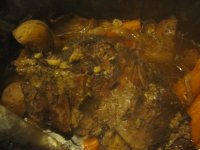I'm going to make Sass's pot roast http://www.netcookingtalk.com/forums/showpost.php?p=180846&postcount=7 tomorrow and load the crockpot before work.
To me, one of the great strengths of using the slow cooker is just to toss everything in it and walk away. One pot to clean (actually, I'm using a slow cooker liner, so I won't even have to do that!).
But a lot of recipes, including this one, say to sear the meat before slow cooking.
I hate to dirty a Dutch oven and take the time to do this.
Do I REALLY have to sear the beef? What's the give-up if I skip that step?
Lee
To me, one of the great strengths of using the slow cooker is just to toss everything in it and walk away. One pot to clean (actually, I'm using a slow cooker liner, so I won't even have to do that!).
But a lot of recipes, including this one, say to sear the meat before slow cooking.
I hate to dirty a Dutch oven and take the time to do this.
Do I REALLY have to sear the beef? What's the give-up if I skip that step?
Lee

